
Interior of the cathedral
A History of Romanesque Architecture
300 AD -1300 AD
High Romanesque 1200-1300 AD
Part 2. Spain, the East, and Italy
Spain and Portugal
Portugal, Oporto, Cathedral, Se do
Porto
5th cent-1110

Interior
of the cathedral
The Romanesque nave is rather narrow and is covered by barrel vaulting. It is flanked by two aisles with a lower vault. The stone roof of the central aisle is supported by flying butresses, making the building one of the first in Portugal to use this architectonic feature.
The external appearance of the Cathedral was greatly altered during
Baroque times. In 1772 a new main portal substituted the old
Romanesque original and the tower cupolas were altered. Around 1732
Italian architect Nicolau Nasoni added an elegant Baroque loggia to
the lateral façade of the Cathedral.
Photo and text Wikipedia
Portugal, Coimbra, Old Cathedral
Se Velha
1140

The
Mozarab-Romanesque Cathedral Se Velha
The most remarkable aspect of the Romanesque decoration of the Old Coimbra Cathedral is the large number of sculpted capitals (some 380), which turns it into one of the most important ensembles of Romanesque sculpture in Portugal.
The main motifs are vegetal and geometric and reveal Arab and pre-romanesque influences, but there are also pairs of quadrupeds (including centaurs) or birds facing each other.
There are virtually no human representations, and no Biblical scenes.
The absence of sculptured human figures may be due to the fact that
many of the artists that worked in the Cathedral were mozarabic, i.e.
Christians who lived in Arab territories and that had settled in
Coimbra in the 12th century. These artists were perhaps not used to
human representations, which are forbidden in Islam.
Photo and
text Wikipedia
Portugal, Lisbon, Cathedral Se
Maria
1147
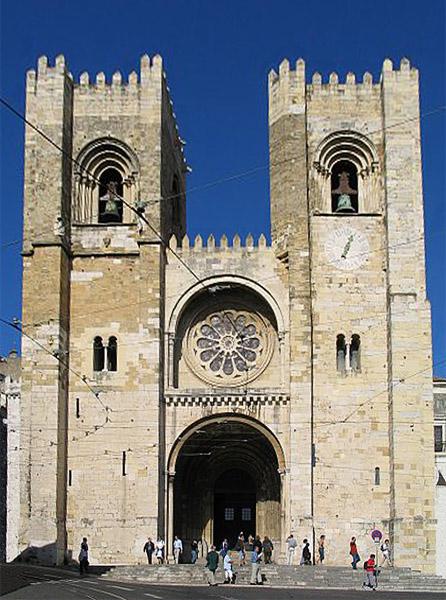
West
façade of the cathedral
Lisbon has been the seat of a bishopric since the 4th century AD. After the Visigothic domination the city was conquered by the Moors and stayed under Arab control from the 8th to the 12th century, although Christians were allowed to live in Lisbon and its surroundings. In the year 1147, the city was reconquered by an army composed of Portuguese soldiers led by King Afonso Henriques and North European crusaders taking part on the Second Crusade. An English crusader named Gilbert of Hastings was placed as bishop, and a new cathedral was built on the site of the main mosque of Lisbon.
From its first building period (1147 until the first decades of the
13th century), Lisbon cathedral has preserved the West façade with a
rose window (rebuilt from fragments in the 20th century), the main
portal, the North lateral portal and the nave of the cathedral. The
portals have interesting sculptured capitals with Romanesque motifs.
The nave is covered by barrel vaulting and has an upper, arched
gallery (triforium). The general plan of the cathedral is very
similar to that of the Old Cathedral of Coimbra, which dates from the
same period.
Photo and text Wikipedia
Spain,9 Romanesque Churches in the
Vall de Boi, Catalonia
12th – 13th cent
The 9 Romanesque Churches in the Vall de Bio, Cataluña,
Never reached by the Arabs, forgotten in the High Pyrenees the Val de Boi was an isolated treasure trove of Spanish Romanesque frescoes of the 12th cent. By 1919 the international art market becamee involved in buying and selling these paintings, which went mostly to museums and private collections in the United States.
The Taüll region became an exception to this trend, since the local population refused to allow the frescoes and other art works to leave their churches. This action reached the attention of the Commonwealth of Catalonia and to the bishop of La Seu d'Urgell. Finally, it was agreed that the frescoes would be best kept in the National Museum of Catalan Art (MNAC), secure from possible theft or unscrupulous transactions. A team of Italian restorers carried out the task of removing the paintings from the walls and, in some cases, replacing the works with in situ reproductions.
Architecturally the churches are all simple one or three-nave basilicas. Their bell towers are their outstanding, visible features. Two of the most important churches are found in Taüll.
Spain, Taüll, Church of San Climent
1123
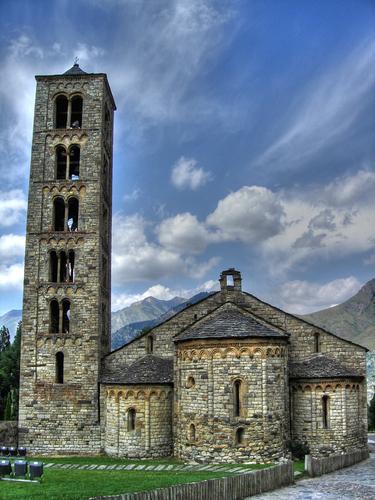
San
Climent de Taüll, photo Panoramio
The date of constuction of Sant Climent de Taüll is unknown, however the church was consecrated on December 10, 1123. The architecture of the church is strongly influenced by the Lombard style, which can be seen especially in its slim bell tower with seven levels.
The facades of the church do not have any sculptural decoration, however the apses have simple Lombard decorations and are built from stone and brick. There are three naves each with an apse. The central apse on the exterior is decorated by groups of four arches, separated by half columns.
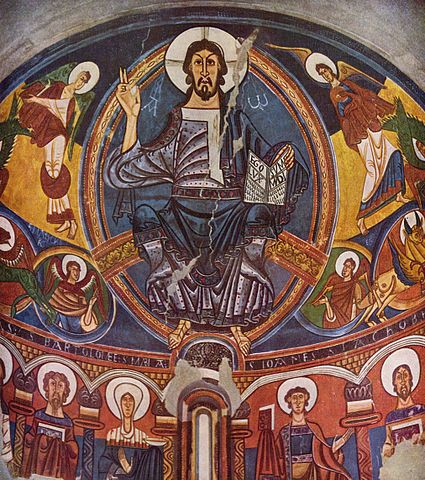
Christ
in Majesty surrounded by a Byzantine deesis of Mary and John the
Baptist
(replica in the church), photo Wikipedia
The interior of the church (the walls of the naves, apses and
columns), were originally covered with polychrome frescoes painted by
a painter, whose identity is unknown, but is referred to as Master of
Taüll. The original mural painting on the northern apse can be seen
in the National Art Museum of Catalonia in Barcelona. The removal of
the mural paintings was done by applying horsehide glue. The hardened
glue was then peeled off, carrying the pigments of the mural with it.
An exact replica of the frescoes was made to replace the originals.
Wikipedia
Spain, Taüll, Church of Santa
Maria
1123
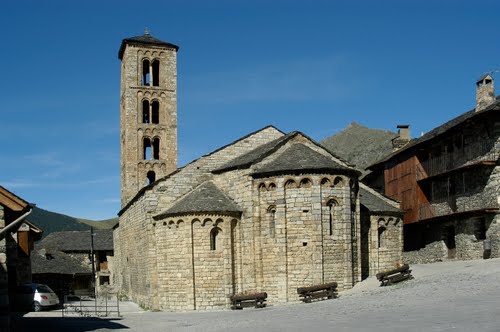
Santa
maria de Taüll, photo Panoramio
The Santa Maria de Taüll is one of the most complete ensembles of Romanesque painting in Spain. Originally, the entire walls of the church were painted. Despite not being preserved intact what we have is enough for us to know with some certainty what themes were represented and how they were distributed inside the church. In the most important part of the church, the apse, the Virgin Mary is portrayed as the Child’s throne in a scene from the Adoration of the Magi.

An
unusual Mary in Majesty surrounded by the Three Kings in an
Epiphany scene
original fresco in the Nat. Museum of
Catalonia, Barcelona, photo Wikipedia
On the side walls of the church there were scenes from the Bible and of saints, distributed in different registers. Next to the side apse, we find, for example, Herod with the Three Wise Men, who, in a synthesis of two different episodes, visit Herod and adore the Child. On the columns of the nave and the interspaces of the arches are frescoes of saints and prophets representative of the Church, amongst them St Clement and St Nicholas. On the west wall was the usual representation of the Day of Judgement and a version of the fight between David and Goliath, which represents the struggle of good against evil.
The church was consecrated by Bishop of Roda and Barbastro on 11 December, 1123 one day after San Climent.
Spain, Benavente, Santa Maria del
Azogue
1180
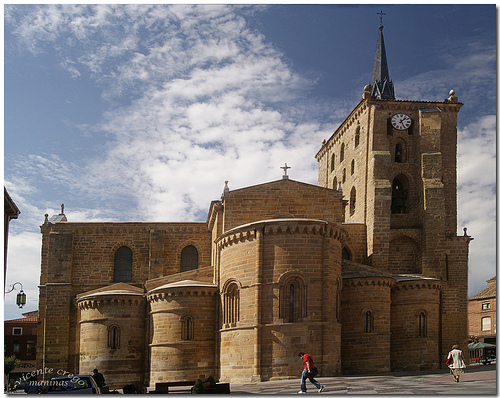
Santa
Maria de Azogue, photo flickr
The church of Santa María de Azogue was begun in the Romanesque
style in 1180. It has a Latin cross plan, with a nave and two aisles,
separated by cruciform pilasters, with five apses. The nave has
Gothic cross vaults added in the 16th century. The interior is home
to several Gothic sculptures, such as an "Annunciation" of
the 13th century.
Wikipedia
Spain, Sepúlveda, Iglesia de El
Salvador
1093
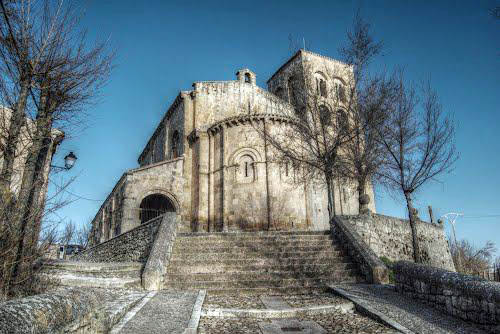
The oldest church in Sepulveda, Romanesque in style (1093). There are
rough carved brackets and capitals that remind one of an older,
pre-Romanesque style.There is a nave, prebestry, and apse with
columns and large windows.The gallery is fortified and the tower has
large arched windows divided by a columns.
From spain-info
Spain, Segovia, San Martin
12th cent
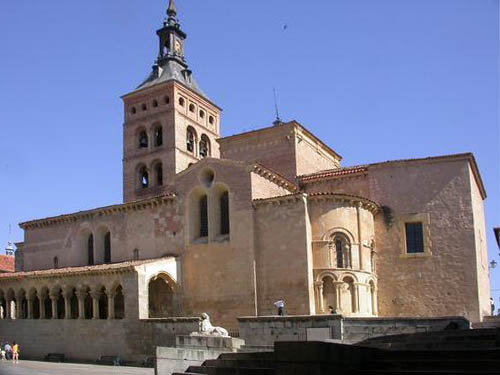
San
Martin, photo Panoramio
This church is one of the most beautiful Romanesque churches in Segovia. There is a porticoed gallery that opens onto the Calle Juan de Juan Bravo. The atrium has round arches resting on columns with Roman capitals. The apses are in the Romanesque style. The mighty church tower in Mudejar style crowns the center of a nave in the shape of a Greek cross. The church features tombs of important people, such as the Herrera Family, and 15th century paintings of the Segovian school. It has a wonderful sculpture of Saint Francis of Assisi by Pedro de Mena. The artist Gregorio Fernandez sculpted the blood-splattered Recumbent Christ. There is a triptych by the Flemish painter Adriaen Isenbrandt (1480-1551) that was brought to the church by Alonso Moreno in the 16th century.
From tripadvisor, - The Spanish Wikipedia Artcicles are even less useful....
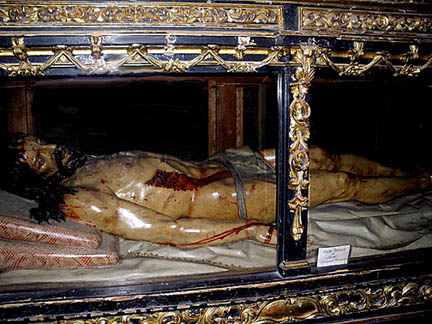
Gregorio
Fernandez's Recumbent Christ
Spain, Zamora, Catedral de
Salvador
1139-1192

photo
Pby
fjmanzanal, Panoramio
The church was built under bishop Esteban, under the patronage of Alfonso VII and his sister, Sancha Raimúndez. The date of construction (1151-1174) is traditionally attested by an epigraphy in the northern side of the transept, although recent discoveries have proven that the church had been already begun in 1139, at the time of bishop Bernardo.
The cathedral was consecrated in 1174 by bishop Esteban, although works continued under his successor Guillermo (1176-1192), including the transept. The cloister and the bell tower date to the first half of the 13th century. The architect of the church is unknown.
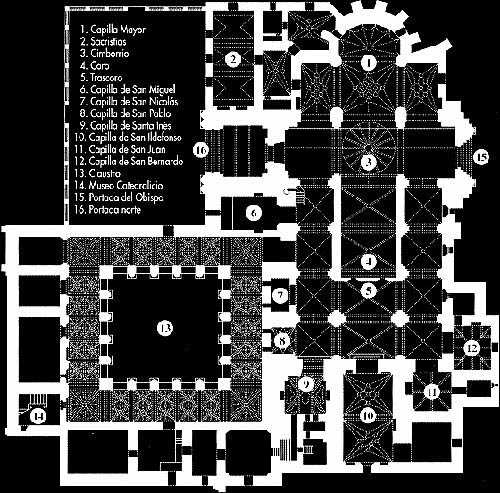
Plan
of the Cathedral with Gothic cloisters (17th cent)

Altar
in the Capella Ildefonso (Flemish 16th cent?)
The Cathedral Museum, in the 17th century cloister, is notable
particularly for its fine Flemish tapestries (Brussels) of the
15th-17th centuries depicting scenes from the Trojan War, Hannibal's
Italian campaign and the life of Tarquin, the Etruscan king of
Rome.
Text and photos Wikipedia
Spain, Soria, Monastery of San
Juan de Duero
12th -13th cent
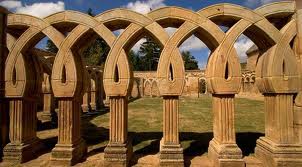
The romantic attraction of San Juan de Durero are the ruins of its cloisters south of the church forming a succession of Mozarab interlaced arches that make up the South side. The later East and West tracts are burdened by their heavy tops and show no sign of having ever been integrated into the whole. The construction of the cloisters can be dated to the mid-thirteenth century.
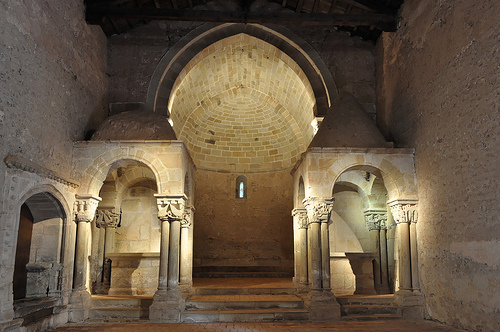
The
apse, early 12th cent.
The very simple interior (restored in the 1950s) is where the real interest and originality of the church lies, accentuated by the poverty of its outside. The delightfully original capitals show the story of Christ, a few apocalyptic scenes, and select examples from the Old Testament.
|
|
|
|
The church was built in the early twelfth century and consisted of a
nave, a short chancel and an apse all of great simplicity. Monks of
the San Juan order used it as their monastic settlement. After the
death of King Alfonso I (1134) his kingdoms of Aragon and Navarre
were taken over by military orders, and in 1243 they established San
Juan as a strong hold for the borderlands between Aragon and Castile.
The monastery was abandoned in the eighteenth century.
Text and
some photos from la
fronteradelduero
Spain, Aguilar de Campoo,
Hermitage of Santa Cecilia
12th cent
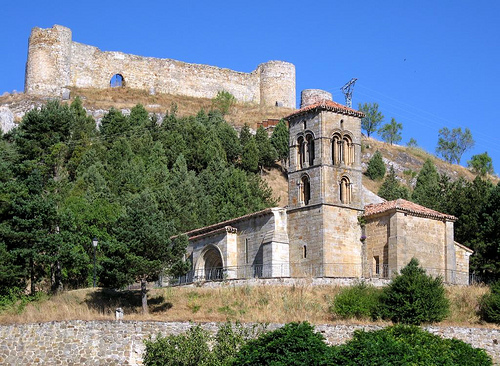
The
Hermitage at the foot of the castle of Aguilar de Campoo
photo
photoviajero
The Hermitage of Santa Cecilia is a simple shrine, quite small (19 x 9 metres), built with strong masonry. It has a single nave, a presbytery and a semicircular apse. The doorway, on the southern face, is protected by an open courtyard. Thanks to this and the prismatic-cubic tower attached to that same wall, it looks like a fortress.
Its list of sculptures is quite outstanding. The doorway has seven pointed archivolts decorated with plant motifs, batons and scotias. The capitals on which they are resting form a "continuous frieze" with Biblical and fantasy scenes.
The bas-relief on the cornice mullions also stand out (some of them
with erotic motifs), on the archivolts and capitals of the apse
window, and on the double pointed triumphal arch inside (serrated
design, scene of Samson and the lion, fantastic animals).
Text
spain-info/conoce
Spain, Monastero de San Andrés
del Arroyo
1181
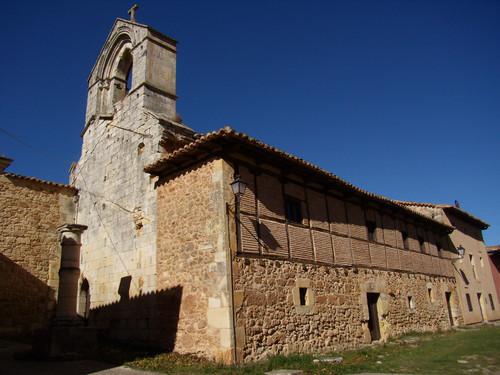
The
Monastery, photo Panoramio
The Monastery of San Andres de Arroyo, whose complete invocation is Santa Maria and San Andres de Arroyo, is a convent of Cistercian nuns. It is an exquisite example of rural Cistercian Art, from the XII and XIII centuries, and therefore in the transition of Romanesque to Gothic .
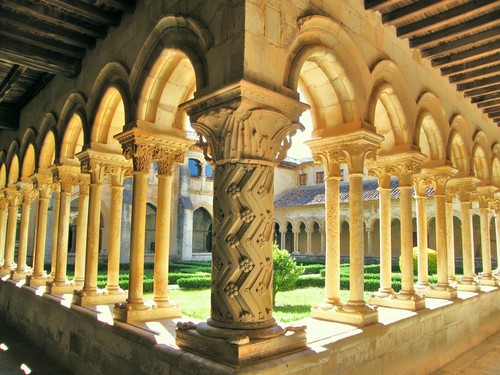
The
cloisters, photo Panoramio
The jewel of the monastery is the cloister of arcs timidly pointed on
slim twin columns and capitals finely worked with vegetal motivs.
Aesthetically it is clearly related to the Claustrillas of Huelgas de
Burgos. The North and South galleries there are sixteen arches. In
the west nineteen are distributed. The Eastern Crujía was
reconstructed in the XVI century in a delayed gothic style, with
vaults of crucería to support to the weight of the upper
gallery.
From myetymology
Barrio de Santa María, Ermita de
Santa Eulalia
Mozarab 12th cent
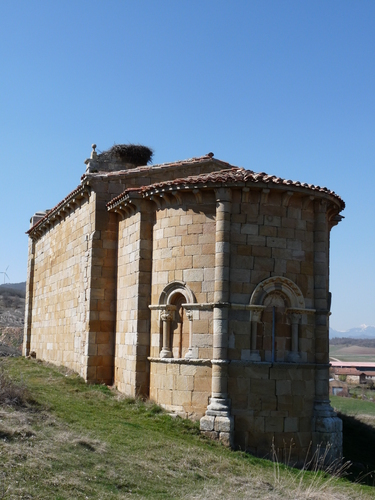
Ermita
de Santa
Eulalia, photo Panoramio
The Hermitage of Santa Eulalia lies with other hermitages (Santa Cecilia, Cillamayor, Olmos de Ojeda) near the tiny village Barrio de Santa Maria northwest of Aquilar de Campoo. All were built by Mozarab refugees from Al-Andalus during the Reconquista of Islamic Spain by the Christian Kingdoms in the north (722-1492).
|
|
|
|
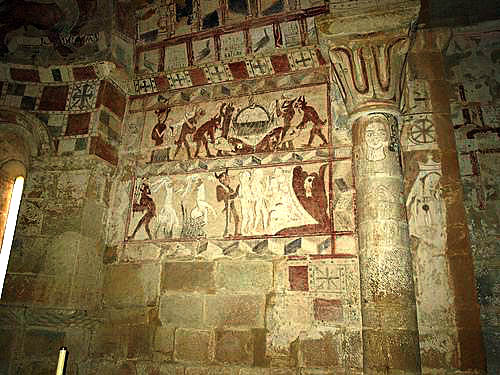
Wall
paintings in the interior
“On the south side of the chancel is a mural of hellish punishment: A devil holding up a big soul who burns carrying a bag around his neck (greed) and other spirits being led to a large boiler. Below demons are roasting souls lashed down, while others are being pushed into the jaws of the Leviathan....” Note the abstract designs. Photo and text translated from flickr
Spain, La Coruña, Iglesia de
Santiago
12th cent
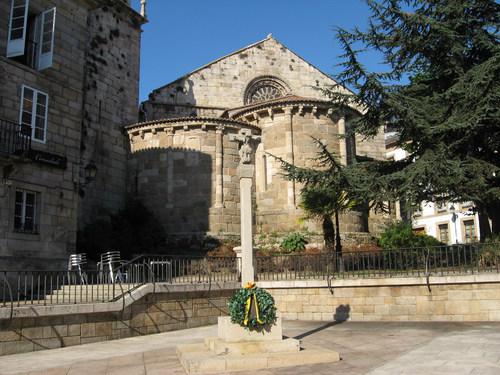
Church
of Santiago, photo Panoramio
The Church of Santiago is the oldest in the
city and was constructed near the end of the 12th century. It seems
to have been built over the remains of a Roman temple. The original
construction was Romanesque, but there have been Gothic additions
after that. The tympanum at the entrance of the church shows a figure
of the Apostle Santiago (St. James) riding a horse. Above this is a
rose window. Inside the church, towards the back, there is a
polychrome statue of Santiago that dates from the 13th century. The
main altarpiece is Neoclassic. There is a very old baptismal font
from the 13th century and the capitals of the columns of the church
have interesting carvings. There is a polychromed statue of Nuestra
Señora de la Esperanza, that is, it shows the Virgin Mary pregnant,
which is very unusual.
tripadvisor
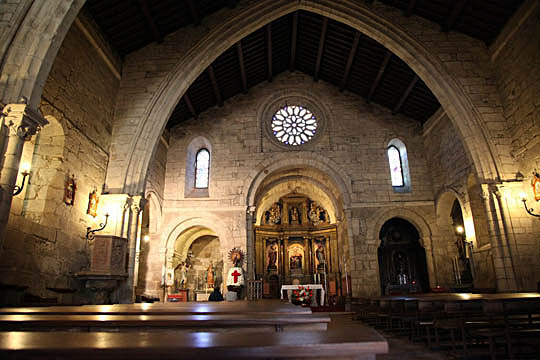
The
Interior, photo Panoramio
Spain, Burgos Cathedral
Romanesque-Gothic, 1221-1567

Burgos
Cathedral rising above the modern town
photo travel2002
Burgos Cathedral, a transitional building between Romanesque and Gothic, was begun in 1221 by King Ferdinand III of Castile on the site of an earlier Romanesque church. The beginning was the chevet (east end), which was completed in nine years. First consecrated in 1260, then there was a lengthy hiatus of almost 200 years before the cathedral was completed in 1567, with the lantern spire over the main crossing.

The
main crossing of the naves, photo tumbler
The architects principally responsible for its construction were a
Frenchman named Enrique (who also worked on Leon Cathedral) in the
13th century and a German named John of Cologne (Juan de Colonia) in
the 15th century. The latter was discovered and hired by the bishop
of Burgos while attending the Council of Constance in 1417.
Text
Sacred
Destinations and Wikipedia
The East
Georgia, Samtavisi Cathedral
1030-12th cent
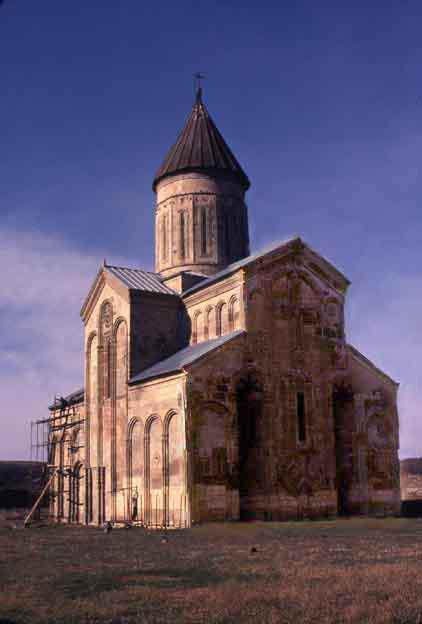
The
Cathedral
Samtavisi is one of the purest examples of classical Georgian architecture (12th cent). Besides its ornaments are exceptionally well preserved
The earliest extant structures date to the eleventh century, the main edifice being built in 1030 as revealed by a now lost stone inscription. The cathedral was built by a local bishop and a skilful architect Hilarion who also authored the nearby church of Ashuriani. Heavily damaged by a series of earthquakes, the Cathedral was partially reconstructed in the 15th and 19th centuries. The masterly decorated eastern façade is the only survived original structure.
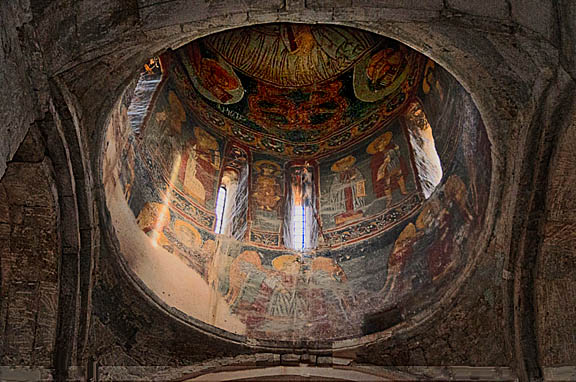
Frescoes
in the interior of the dome (16th cent?), Photos RWFG
The Samtavisi Cathedral is a rectangular 4-piered cruciform domed
church. It illustrates a Georgian interpretation of the
cross-in-square form which set an example for many churches built in
the heyday of medieval Georgia. The exterior is distinguished by the
liberal use of ornamental blind arcading. The apses do not project,
but their internal position is marked by deep recesses in the wall.
In contrast to earlier Georgian churches, the drum of the dome is
taller surmounted by a conical roof. Artistically, the most rounded
portion of the church is its five-arched eastern façade, dominated
by the two niches and enlivened by a bold ornate cross
motif.
Wikipedia
Georgia, Kintsvisi, St. Nicholas
Cathedral
1205
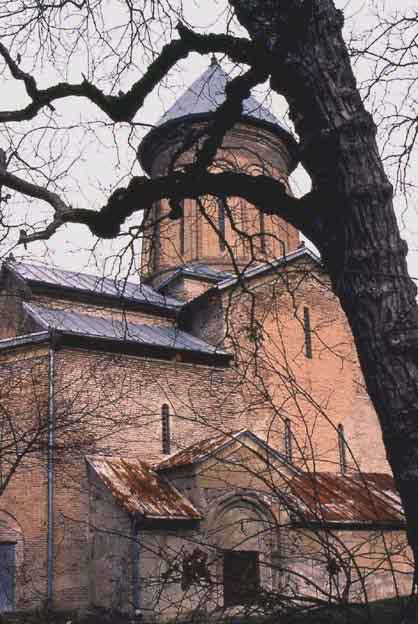
The
church
The church of Kintsvisi, dedicated to St. Nicholas, is most famous
for its brightly coloured monumental paintings: the backgrounds are
painted entirely in lapis-lazuli. Figures are depicted in blues, warm
browns, ochres and reds. Thanks to the portraits of three sovereigns
– one of them being Queen Tamar – and the church’s donor, Prime
Minister Antonij, these murals can be dated to before 1205 and rank,
together with those of Timotesubani and Vardzia, among the most
beautiful paintings of that period. The enthroned Virgin with child
accompanied by angels and archangels is represented in the church’s
apse, while the cross in the cupola is surrounded by a Deesis and
archangels. Medallions with the Evangelists adorn the pendentives,
and a vast Christological cycle is depicted on the walls as is a St.
Nicholas cycle. The building of the church of St. Nicholas is an
inscribed-cross type building. The use of brick, which is quite
unusual for Georgian architecture of this period.
Max
Planck Institute Florence
|
|
|
In the central position of the cupola is the Hodegetria flanked by the archangels Michael and Gabriel. At the central part of cupola arch is an expressed cross as a medallion. Medallions with the Four Evangelists adorn the pendentives. Images of archangels are repeated on south and west walls of the church. Scenes from the New Testament are presented on north walls, as are portraits of Georgian kings, Giorgi III, Tamar and Giorgi IV Lasha. Particularly remarkable is the figure of a sitting angel (the so-called “Kintsvisi Archangel”) from the Resurrection composition pointing at the open sarcophagus in a gracious manner, represented above the kings' figures, between two windows. These murals date to before 1205 and rank, due to the lavish use of lapis-lazuli to color their backgrounds, among the most beautiful paintings of that period.
These murals were ordered by Anton Gnolistavisdze, a local feudal magnate who served as a royal minister. His fresco with a model of a church in his hand is represented on the lower register of the south wall, along with a severely damaged cycle of images from the life of St Nicholas, and depictions of various Georgian saints.
The murals of the narthex are of a later date, and were painted by
the order of a prominent person of the 15th century, Zaza
Panaskerteli, whose portrait is represented here as well.
Wikipedia
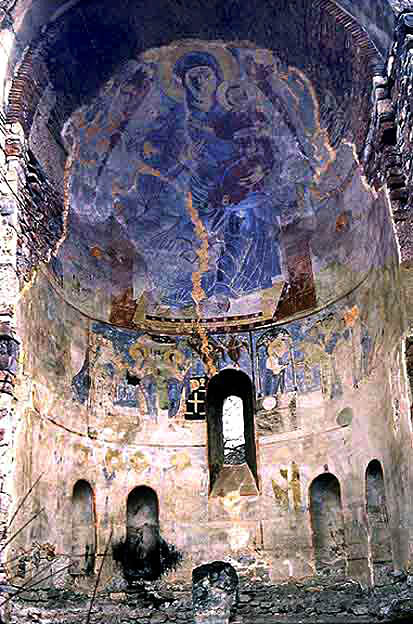
The
remaining apse of St. Mary's Church, 10th-11th cent
Photos RWFG
Near the St. Nicholas church an apse of a church dedicated to St. Mary, has survived, which was presumably also entirely painted. In its apse an enthroned Hodegetria is represented above a Communion of the Apostles.
Turkey, Trabzon, Aghia Sofia
1238-1263

South
side of the Hagia Sophia Trebizond
Hagia Sophia in Trebizond was built during the reign of Manuel I
between 1238 and 1263. After Mehmed II conquered the city in 1461 the
church was converted into a mosque, and its frescos covered in
whitewash. During World War I and for a brief period afterward, the
city was occupied by the Russian military and used as a makeshift
hospital and depot. Afterwards it was put back into use as a mosque,
until 1964 when it was turned into a museum.
Text Wikipedia
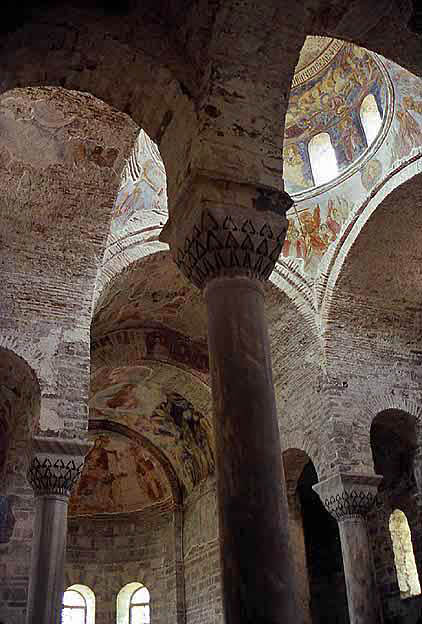
Four
antique columns carry the dome
From 1958 to 1964 the frescoes were uncovered and the church consolidated with the help of experts from Edinburgh University and the General Directorate of Foundations. The late 13th-century frescos, revealed during the Edinburgh University restoration, illustrate New Testament themes. External stone figurative reliefs and other ornamenting is in keeping with local traditions found in Georgia and Armenia.
|
|
The 1964 restored frescoes of 1250 Photos RWFG |
|
The Last Glorious Mosaics 11th-12th cent
Italy,
Florence, Baptistry San Giovanni
1059 -1128, 1225

The
mosaic ceiling of the Baptistry 1225, photo Wikipedia
The Baptistry is crowned by a magnificent mosaic ceiling. The earliest mosaics, works of art of many unknown Venetian craftsmen (including probably Cimabue), date from 1225. The covering of the ceiling started under the direction of the Franciscan friar Jacopo da Torrita and was probably not completed until the fourteenth century.
This mosaic cycle depicts in the three sections above the high altar, the Last Judgment with a gigantic, majestic Christ and the Angels of Judgment at each side by Coppo di Marcovaldo, the rewards of the saved leaving their tomb in joy (at Christ's right hand), and the punishments of the damned (at Christ's left hand). This last part is particularly famous: evil doers are burnt by fire, roasted on spits, crushed with stones, bit by snakes, gnawed and chewed by hideous beasts. These scenes remind us of later works showing us in grisly detail the horrors of hell, such as The Last Judgment or the panel Hell (from the triptych The Garden of Earthly Delights), both by the Flemish painter Hieronymus Bosch.
Dante Alighieri, who grew up looking at these mosaics and these images of death and resurrection, must have been deeply impacted.
The other scenes on the ceiling depict different stories in horizontal tiers: (starting at the top) Choirs of Angels, Thrones, Dominations, and Powers; stories.
Of course, there are also the famous doors, but they are from the 15th cent.
Italy, Venice, Basilica of San
Marco, the Ceiling Mosaics
1075-1250

San
Marco, Genesis, the Creation, 12th cent, photo RWFG
An annotated list of the mosaics in Italy is found in the Web-Gallery of Art
Italy, Rome, Basilica San
Clemente, The Mosaics
1099-1120

Mosaic
in the apse, 1099-1120,
photo wordpress
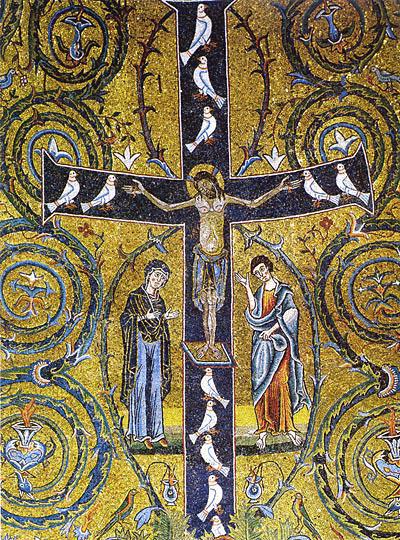
The
Crucifixion

The
Spring of Life under the Crucifixion, photos Web
Gallery of Art
More see Wikipedia
Italy, Cefalú, Cathedral San
Pietro
Norman 1131
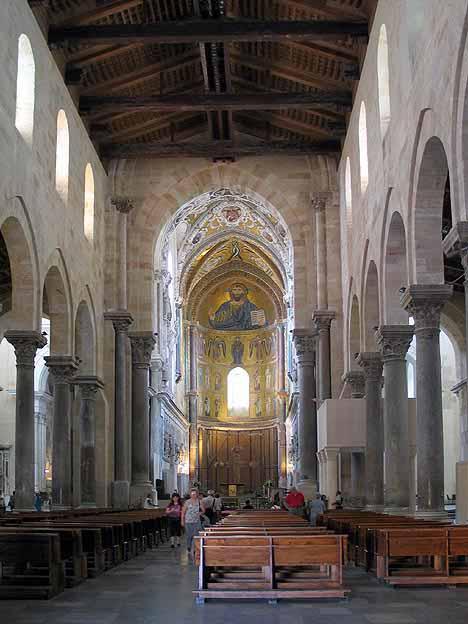
Cefalú
the Nave
The cathedral had been stuccoed during the Baroque period, destroying the mosaics on the walls of the nave, maybe because they had too strong an Eastern flavor. A recent renovation removed the Baroque stucco, which, if it did not recover the lost mosaics, freed the walls of all late additions, a singular renovation for Sicily. It has become a beautiful, clear interior. Of the mosaics (1140) only those of the apse have survived.
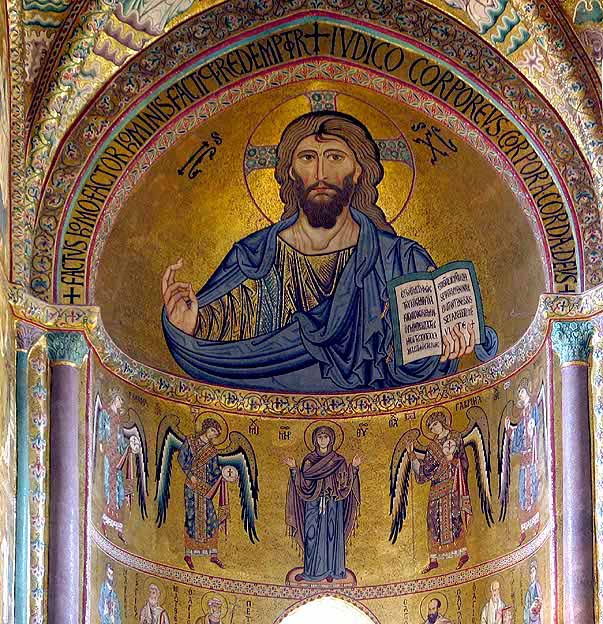
the
mystical, neoplatonic Christ 1145
photos RWFG
The work of Byzantine craftsmen, strongly influenced by Eastern-Orthodox, neoplatonic theology (Christ as Man) —100 years after the Schism — and 30 years before the Cathedral in Monreale.
Starting in 1985, Palermo artist Michele Canzoneri has installed 72 controversial, modern, abstract stained glass windows based on episodes from the Old and New Testaments
Italy, Palermo, Cappella Palatina
1130-1143

Built by Arabic and Byzantine craftsmen in the employ of Norman King Roger II, the Cappella Palatina was his private chapel. This golden cave is a wonder of the harmonious synergism of Byzantine mosaic art, Arabic intarsia, and Norman architecture.
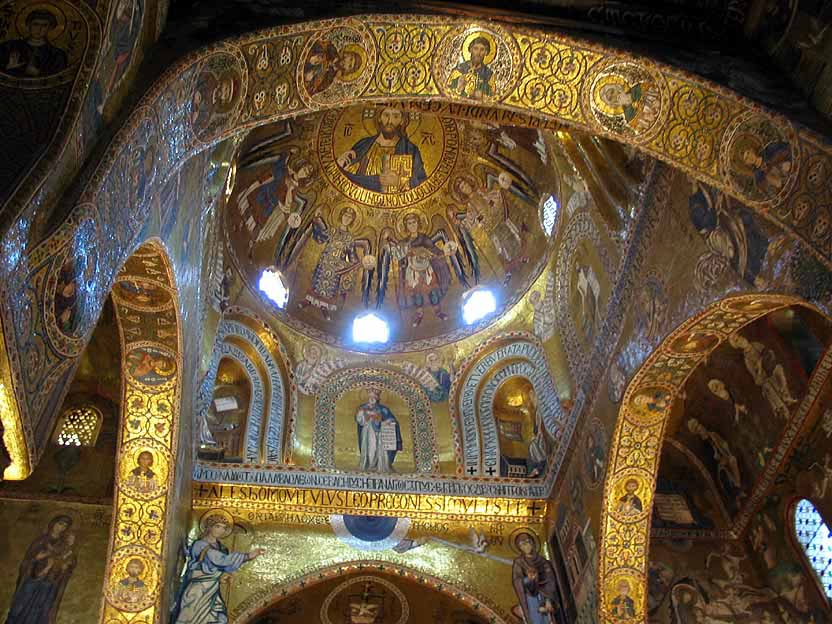
The
dome: Christ Pantocrator surrounded by Archangels (like in the
Baptisterium in Florence)
according to the neoplatonic teachings
of the pseudo-Dionysius
Areopagitus — in
this case beyond a doubt.
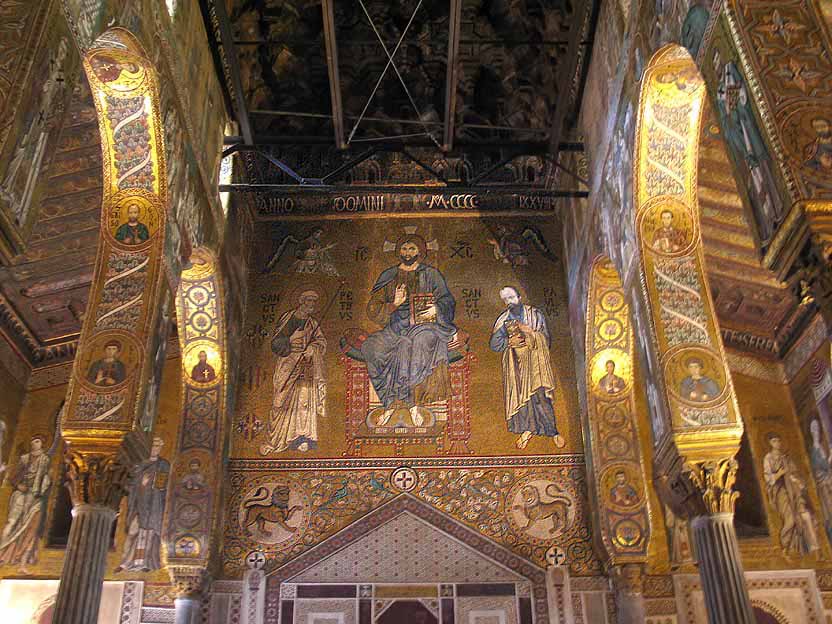
Christ
seconded by St. Peter and St. Paul, photos RWFG
Roger II ruled over Sicily from 1112, when he came of age, to 1156.
Calabria and Apulia in southern Italy also came under his control,
and he reached the apogee of his power in 1130, when he became the
first Norman king of Sicily. His political ambitions extended towards
the Byzantine empire in the East, and in 1147 he seized Corfu.
Roger's political aspirations are nowhere more explicit than in his
mosaic portrait in the church of Santa Maria dell'Ammiraglio (known
as the Martorana) in Palermo. It shows him dressed in the manner of a
Byzantine emperor, being crowned by Christ himself, rather than by
Christ's earthly representative, the pope. This was a traditional
arrangement of Byzantine imagery. The mosaic not only indicates
Roger's relationship with the papacy, as the Church is made
subordinate to the state, but also underlines the Norman ruler's
aspiration to conquer the Byzantine empire.
Web
Gallery of Art
Italy, Palermo, Martorana
1143-1150

The
Nave, photo Sacred
Destinations
The church was founded in 1143 by George of Antioch, the admiral of Norman King Roger. Dedicated to the Virgin Mary, it became known as Santa Maria dell'Ammiraglio, "St. Mary of the Admiral." The church's more common name comes from Eloisa Martorana, who founded a nearby Benedictine convent in 1194.
Norman-Byzantine mosaics from c.1150 cover the interior, including on and around the columns that hold up the principal cupola. The mosaics were overseen by George of Antioch himself, who was of Greek descent and loved the Byzantine mosaics of his homeland. Scholars think the craftsmen who designed these mosaics also did the mosaic work in the Cappella Palatina
|
|
|
|
Even after 850 years, the colors remain vibrant: the golden
background is pierced with streaks of spring green, ivory, azure
blue, and red. High along the western wall is some of the oldest and
best-preserved mosaic artwork of the Norman period. Just inside the
entrance is an interesting mosaic of King Roger II being crowned by
Christ. Roger is dressed in a jeweled Byzantine stole, reflecting the
Norman court's penchant for all things Byzantine. Archangels along
the ceiling wear the same stole. Another mosaic panel shows the
prostrated Admiral, George of Antioch, founder
of the church, dedicating La Martorana to the Virgin. Dominating the
dome is a mosaic of a gentle-looking Christ, seated on a throne and
surrounded by angels. The Madonna and the Apostles are shown off to
the sides.
Sacred
Destinations
Italy, Palermo, Cathedral Monreale
1180
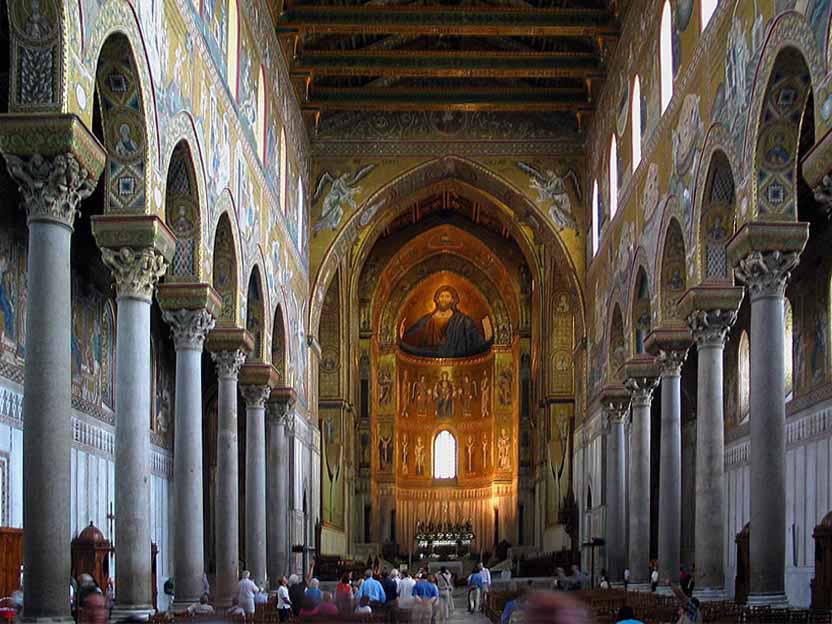
The
Nave, photo RWFG
The cathedral of Monreale was built after 1180 by William I, the son of Roger II. Since Roger II's time the spirit of the mosaics has changed from a neo-platonic mysticism emphasizing the Eastern-Orthodox canon to a depiction of scenes from the Old and New Testament according to Western, Roman tradition. The left side of the nave now shows New Testament scenes from the life of Christ. The right the Old Testament. And Christ has become catholic and has aged some 30 years since Cefalu and the Palatina:
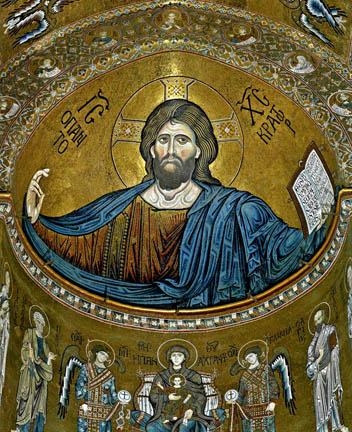
The
Western, Catholic Christ Pantocrator in the Apse, 1180
photo
Web Gallery of Art
Turkey, Constantinople-Istanbul,
Last Mosaics in the Haghia Sophia
1261
|
|
|
Parts of a deesis, Christ and John the Baptist, now removed from the walls and on exhibition in the upper story (women's galleries) of the church. This deesis was commissioned by Emperor Michael III Paleologos in 1261 after the Latin crusaders had ransacked the church and Constantinopole. They are among the most sophisticated Byzantine mosaics extant. Photos RWFG
Italy, Florence, San Miniato al
Monte
1140-1260

The
Nave with a mosaic of Christ between the Virgin and Sta. Minas,
1260
photo Wikipedia
San Miniato in Florence, perhaps my most beloved church, does not boast with gold mosaics, instead it has a modest wooden roof ceiling and its walls are covered with most delicate Florentine marble intarsis: Renaissance's first blossom.
The interior exhibits the early feature of a choir raised on a platform above the large crypt. It has changed little since it was first built. The patterned pavement dates from 1207. The centre of the nave is dominated by the beautiful freestanding Cappella del Crocefisso (Chapel of the Crucifix), designed by Michelozzo in 1448. It originally housed the miraculous crucifix now in Santa Trìnita and is decorated with panels long thought to be painted by Agnolo Gaddi. The terracotta decoration of the vault is by Luca della Robbia.
The mosaic of Christ between the Virgin and St Minias was made in
1260.
Wikipedia